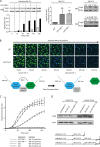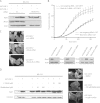Cytotoxic necrotizing factor-Y boosts Yersinia effector translocation by activating Rac protein
- PMID: 23803609
- PMCID: PMC3949328
- DOI: 10.1074/jbc.M112.448662
Cytotoxic necrotizing factor-Y boosts Yersinia effector translocation by activating Rac protein
Abstract
Pathogenic Yersinia spp. translocate the effectors YopT, YopE, and YopO/YpkA into target cells to inactivate Rho family GTP-binding proteins and block immune responses. Some Yersinia spp. also secrete the Rho protein activator cytotoxic necrotizing factor-Y (CNF-Y), but it has been unclear how the bacteria may benefit from Rho protein activation. We show here that CNF-Y increases Yop translocation in Yersinia enterocolitica-infected cells up to 5-fold. CNF-Y strongly activated RhoA and also delayed in time Rac1 and Cdc42, but when individually expressed, constitutively active mutants of Rac1, but not of RhoA, increased Yop translocation. Consistently, knock-out or knockdown of Rac1 but not of RhoA, -B, or -C inhibited Yersinia effector translocation in CNF-Y-treated and control cells. Activation or knockdown of Cdc42 also affected Yop translocation but much less efficiently than Rac. The increase in Yop translocation induced by CNF-Y was essentially independent of the presence of YopE, YopT, or YopO in the infecting Yersinia strain, indicating that none of the Yops reported to inhibit translocation could reverse the CNF-Y effect. In summary, the CNF-Y activity of Yersinia strongly enhances Yop translocation through activation of Rac.
Keywords: CNF-Y; Cdc42; Cytotoxic Necrotizing Factor-Y; Rac; Rho; Rho GTPases; Toxins; Type III Secretion System; Yersinia enterocolitica.
Figures





Similar articles
-
The cytotoxic necrotizing factor of Yersinia pseudotuberculosis (CNFY) enhances inflammation and Yop delivery during infection by activation of Rho GTPases.PLoS Pathog. 2013;9(11):e1003746. doi: 10.1371/journal.ppat.1003746. Epub 2013 Nov 7. PLoS Pathog. 2013. PMID: 24244167 Free PMC article.
-
Analysis of chaperone-dependent Yop secretion/translocation and effector function using a mini-virulence plasmid of Yersinia enterocolitica.Int J Med Microbiol. 2003 Jun;293(2-3):167-77. doi: 10.1078/1438-4221-00251. Int J Med Microbiol. 2003. PMID: 12868653
-
Yersinia controls type III effector delivery into host cells by modulating Rho activity.PLoS Pathog. 2008 Jan;4(1):e3. doi: 10.1371/journal.ppat.0040003. PLoS Pathog. 2008. PMID: 18193942 Free PMC article.
-
Modulation of Rho GTPases and the actin cytoskeleton by Yersinia outer proteins (Yops).Int J Med Microbiol. 2001 Sep;291(4):269-76. doi: 10.1078/1438-4221-00130. Int J Med Microbiol. 2001. PMID: 11680787 Review.
-
Cellular mechanisms of bacterial internalization counteracted by Yersinia.Int Rev Cytol. 2005;246:135-88. doi: 10.1016/S0074-7696(05)46004-0. Int Rev Cytol. 2005. PMID: 16164968 Review.
Cited by
-
Yersinia versus host immunity: how a pathogen evades or triggers a protective response.Curr Opin Microbiol. 2016 Feb;29:56-62. doi: 10.1016/j.mib.2015.11.001. Epub 2015 Nov 27. Curr Opin Microbiol. 2016. PMID: 26638030 Free PMC article. Review.
-
The Cytotoxic Necrotizing Factors (CNFs)-A Family of Rho GTPase-Activating Bacterial Exotoxins.Toxins (Basel). 2021 Dec 15;13(12):901. doi: 10.3390/toxins13120901. Toxins (Basel). 2021. PMID: 34941738 Free PMC article. Review.
-
Characterization of Photorhabdus Virulence Cassette as a causative agent in the emerging pathogen Photorhabdus asymbiotica.Sci China Life Sci. 2022 Mar;65(3):618-630. doi: 10.1007/s11427-021-1955-4. Epub 2021 Jun 25. Sci China Life Sci. 2022. PMID: 34185241
-
Analysis of Yersinia enterocolitica Effector Translocation into Host Cells Using Beta-lactamase Effector Fusions.J Vis Exp. 2015 Oct 13;(104):53115. doi: 10.3791/53115. J Vis Exp. 2015. PMID: 26484613 Free PMC article.
-
Yersinia Pseudotuberculosis Modulates Regulatory T Cell Stability via Injection of Yersinia Outer Proteins in a Type III Secretion System-Dependent Manner.Eur J Microbiol Immunol (Bp). 2018 Nov 28;8(4):101-106. doi: 10.1556/1886.2018.00015. eCollection 2018 Dec 23. Eur J Microbiol Immunol (Bp). 2018. PMID: 30719325 Free PMC article.
References
-
- Prentice M. B., Rahalison L. (2007) Plague. Lancet 369, 1196–1207 - PubMed
-
- Viboud G. I., Bliska J. B. (2005) Yersinia outer proteins: role in modulation of host cell signaling responses and pathogenesis. Annu. Rev. Microbiol. 59, 69–89 - PubMed
-
- Trülzsch K., Oellerich M. F., Heesemann J. (2007) Invasion and dissemination of Yersinia enterocolitica in the mouse infection model. Adv. Exp. Med. Biol. 603, 279–285 - PubMed
-
- Heesemann J., Sing A., Trülzsch K. (2006) Yersinia's stratagem: targeting innate and adaptive immune defense. Curr. Opin. Microbiol. 9, 55–61 - PubMed
-
- Navarro L., Alto N. M., Dixon J. E. (2005) Functions of the Yersinia effector proteins in inhibiting host immune responses. Curr. Opin. Microbiol. 8, 21–27 - PubMed
Publication types
MeSH terms
Substances
LinkOut - more resources
Full Text Sources
Other Literature Sources
Research Materials
Miscellaneous

